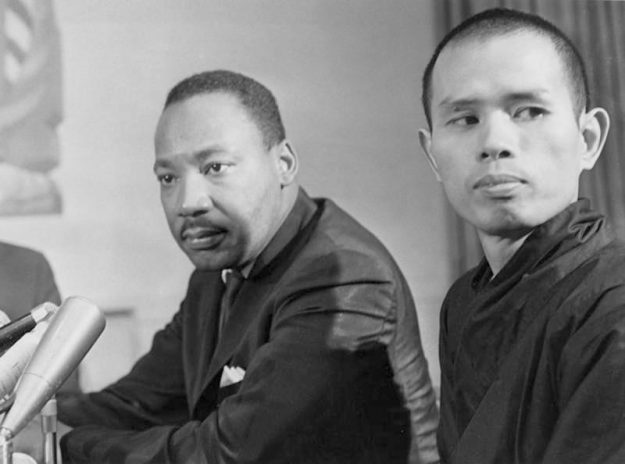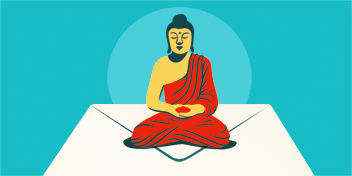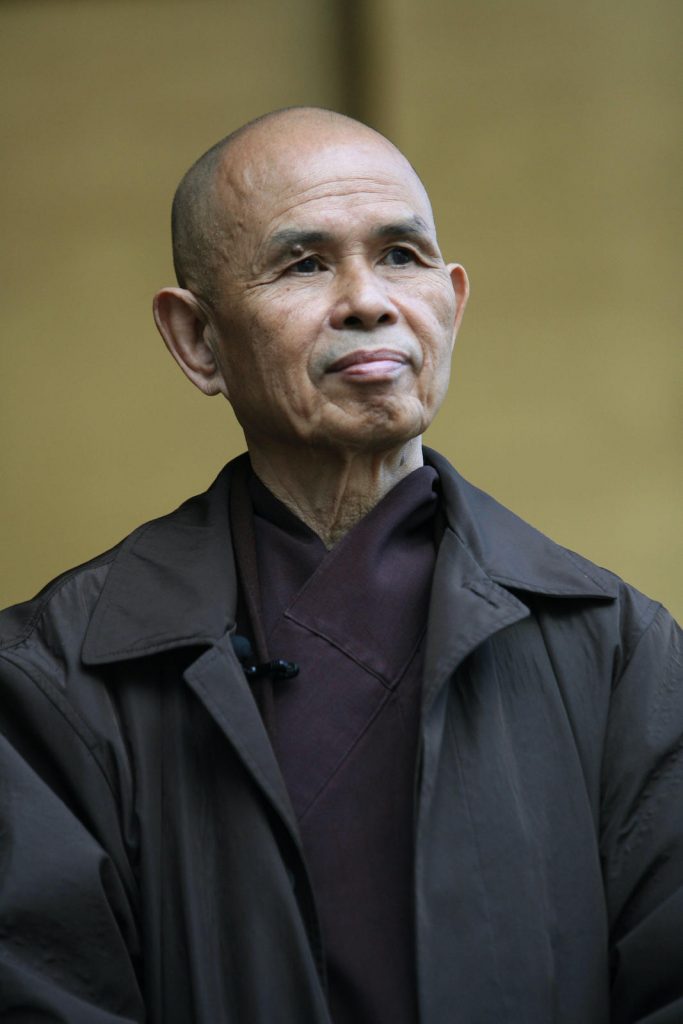Vietnamese Zen Master Thich Nhat Hanh—a world-renowned spiritual leader, author, poet, and peace activist—died on January 22, 2022 at midnight (ICT) at his root temple, Tu Hieu Temple, in Hue, Vietnam. He was 95.
“Our beloved teacher Thich Nhat Hanh has passed away peacefully,” his sangha, the Plum Village Community of Engaged Buddhism, said in a statement. “We invite our global spiritual family to take a few moments to be still, to come back to our mindful breathing, as we together hold Thay in our hearts in peace and loving gratitude for all he has offered the world.”
Thich Nhat Hanh had been in declining health since suffering a severe brain hemorrhage in November 2014, and shortly after his 93rd birthday on October 10, 2019, he had left Tu Hieu Temple to visit a hospital in Bangkok and stayed for a few weeks at Thai Plum Village in Pak Chong, near Khao Yai National Park before returning to Hue on January 4, 2020. He had returned to Vietnam in late 2018, expressing a wish to spend his remaining days at his root temple.
Known to his thousands of followers worldwide as Thây—Vietnamese for teacher—Nhat Hanh was widely considered among Buddhists as second only to His Holiness the 14th Dalai Lama in the scope of his global influence. The author of some 100 books—75 in English—he founded nine monasteries and dozens of affiliated practice centers, and inspired the creation of thousands of local mindfulness communities. Nhat Hanh is credited with popularizing mindfulness and “engaged Buddhism” (he coined the term), teachings that not only are central to contemporary Buddhist practice but also have penetrated the mainstream. For many years, Thich Nhat Hanh has been a familiar sight the world over, leading long lines of people in silent “mindful” walking meditation.
It is difficult to overstate the importance of Thich Nhat Hanh’s role in the development of Buddhism in the West, particularly in the United States. He was arguably the most significant catalyst for the Buddhist community’s engagement with social, political, and environmental concerns. Today, this aspect of Western Buddhism is widely accepted, but when Nhat Hanh began teaching regularly in North America, activism was highly controversial in Buddhist circles, frowned upon by most Buddhist leaders, who considered it a distraction from the focus on awakening. At a time when Western Buddhism was notably parochial, Nhat Hanh’s nonsectarian view motivated many teachers to reach out and build bonds with other dharma communities and traditions. It would not be an exaggeration to say that his inclusive vision laid the groundwork for the flourishing of Buddhist publications, including Tricycle, over the past 35 years.
At the heart of Thich Nhat Hanh’s approach to Buddhism was his emphasis on dependent origination, or what he called “interbeing.” Although this is a core teaching shared by all schools of Buddhism, prior to Nhat Hanh, it received little attention among Western Buddhists outside of academia. Today, it is central to dharma practice. Nhat Hanh viewed dependent origination as the thread that tied together all Buddhist traditions, linking the teachings of the Pali canon, the Mahayana teachings on emptiness, and the Huayen school’s vision of radical interdependence.
While Thich Nhat Hanh was a singular and innovative teacher and leader, he was also steeped in the Buddhist tradition of his native Vietnam. More than any other Zen master, he brought the essential character of Vietnamese Buddhism—ecumenical, cosmopolitan, politically engaged, artistically oriented—to the mix of cultural influences that have nourished the development of Buddhism in the West.
Born Nguyen Xuan Bao in central Vietnam in 1926, Nhat Hanh was 16 when he joined Tu Hieu Temple in Hue as a novice monk in the Linchi (Rinzai in Japanese) school of Vietnamese Zen. He studied at the Bao Quoc Buddhist Academy but became dissatisfied with the conservatism of the teachings and sought to make Buddhist practice more relevant to everyday life. (Tellingly, he was the first monk in Vietnam to ride a bicycle.) Seeking exposure to modern ideas, he studied science at Saigon University, later returning to the Buddhist Academy, which incorporated some of the reforms he had proposed. Nhat Hanh took full ordination in 1949 at Tu Hieu, where his primary teacher was Zen master Thanh Quý Chân Thậ.
In the 1950s and early 1960s, Nhat Hanh assumed leadership roles that were harbingers of the prolific writing and unrelenting activism that his future held in store. In the early 50s, he started a magazine, The First Lotus Flowers of the Season, for visionaries promoting reforms, and later edited Vietnamese Buddhism, a periodical of the Unified Buddhist Church of Vietnam (UBCV), a group that united various Buddhist sects in response to government persecution at the time. In 1961, Vietnamese Buddhism was closed down by conservative Buddhist leaders, but Nhat Hanh continued to write in opposition to government repression and to the war that was escalating in Vietnam.
Nhat Hanh first traveled to the United States in 1961, to study comparative religion at Princeton University. The following year, he was invited to teach Buddhism at Columbia University. In 1963, as the Diem regime increased pressure on Vietnamese Buddhists, Nhat Hanh traveled around the US to garner support for peace efforts at home. After the fall of Diem, he returned to Vietnam, and in 1964 devoted himself to peace activism alongside fellow monks. Nhat Hanh became a widely visible opponent of the war, and established the School of Youth for Social Service (SYSS), a training program for Buddhist peace workers who brought schooling, health care, and basic infrastructure to villages throughout Vietnam. In February 1966, with six SYSS leaders, he established the Order of Interbeing, an international sangha devoted to inner peace and social justice, guided by his deep ethical commitment to interdependence among all beings.
On May 1, 1966, at Tu Hieu Temple, Nhat Hanh received dharma transmission from Master Chan That, becoming a teacher of the Lieu Quan dharma line in the forty-second generation of the Lam Te Dhyana school. Shortly thereafter, he toured North America, calling for an end to hostilities in his country. He urged US Secretary of Defense Robert S. McNamara to stop bombing Vietnam and, at a press conference, outlined a five-point peace proposal. On that trip he also met with the Trappist monk, social activist, and author Thomas Merton at Merton’s abbey in Kentucky. Recognizing a kindred spirit, Merton later published an essay, “Nhat Hanh Is My Brother.”

While in the US, Nhat Hanh urged the Reverend Dr. Martin Luther King Jr. to publicly condemn the war in Vietnam. In April 1967, King spoke out against the war in a famous speech at New York City’s Riverside Church. A Nobel Laureate, King nominated Nhat Hanh for the Nobel Peace Prize in a letter to the Nobel Committee that called the Vietnamese monk “an apostle of peace and nonviolence, cruelly separated from his own people while they are oppressed by a vicious war.” Nhat Hanh did not receive the Nobel Peace Prize: in publicly announcing the nomination, King had violated a strict prohibition of the Nobel Committee.
Thich Nhat Hanh’s anti-war activism and refusal to take sides angered both North and South Vietnam, and following his tour of the US and Europe, he was barred from returning to his native land. He was granted asylum in France, where he was named to lead the Buddhist peace delegation to the Paris Peace Accords. In 1975, Nhat Hanh founded Les Patates Douce, or the “Sweet Potato” community near Paris. In 1982, it moved to the Dordogne in southwestern France and was renamed Plum Village. What began as a small rural sangha has since grown into a home for over 200 monastics and some 8,000 yearly visitors. Always a strong supporter of children, Nhat Hanh also founded Wake Up, an international network of sanghas for young people.
After 39 years in exile, Nhat Hanh returned to Vietnam for the first time in 2005 and again in 2007. During these visits, he gave teachings to crowds numbering in the thousands and also met with the sitting Vietnamese president, Nguyen Minh Triet. Though greeted with considerable fanfare, the trips also prompted criticism from Nhat Hanh’s former peers at UBCV, who thought the visits granted credibility to an oppressive regime. But consistent with his stand of many years, Nhat Hanh made both private and public proposals urging the Vietnamese government to ease its restrictions on religious practice.
Fluent in English, French, and Chinese, as well as Vietnamese, Nhat Hanh continued to travel the world teaching and leading retreats until his stroke in 2014, which left him unable to speak. But Nhat Hanh’s legacy carries on in his vast catalogue of written work, which includes accessible teachings, rigorous scholarship, scriptural commentary, political thought, and poetry. Beloved for his warm, evocative verse, Nhat Hanh published a collection of poetry entitled Call Me By My True Names in 1996. His instructive and explicatory work includes Vietnam: Lotus in a Sea of Fire, published in 1967, and such best-sellers as Peace is Every Step (1992), The Miracle of Mindfulness (1975, reissued 1999), and Living Buddha, Living Christ (1995).
In addition to his followers worldwide, Nhat Hanh leaves behind many close brothers and sisters in the dharma, most notably Sister Chan Khong. A longtime friend and activist in her own right, she has assumed a more pronounced leadership role in the sangha in recent years.
♦
Articles by Thich Nhat Hanh
Interbeing with Thich Nhat Hanh: An Interview
Zen master Thich Nhat Hanh was born in central Vietnam in October 1926 and became a monk at the age of sixteen.
The Fertile Soil of Sangha
Thich Nhat Hanh on the importance of community.
The Heart of the Matter
Thich Nhat Hanh answers three questions about our emotions
Walk Like a Buddha
Arrive in the here and the now.
Free from Fear
When we are not fully present, we are not really living
Cultivating Compassion
How to love yourself and others
Thich Nhat Hanh’s Little Peugeot
The Zen master reflects on our culture of empty consumption and his community’s connection to an old French car.
Why We Shouldn’t Be Afraid of Suffering
Instead, we should fear not knowing how to handle our suffering, according to Zen master Thich Nhat Hanh.
Fear of Silence
While we can connect to others more readily than ever before, are we losing our connection to body and mind? A Zen master thinks so, and offers a nourishing conscious breathing practice as a remedy.
Thank you for subscribing to Tricycle! As a nonprofit, we depend on readers like you to keep Buddhist teachings and practices widely available.

